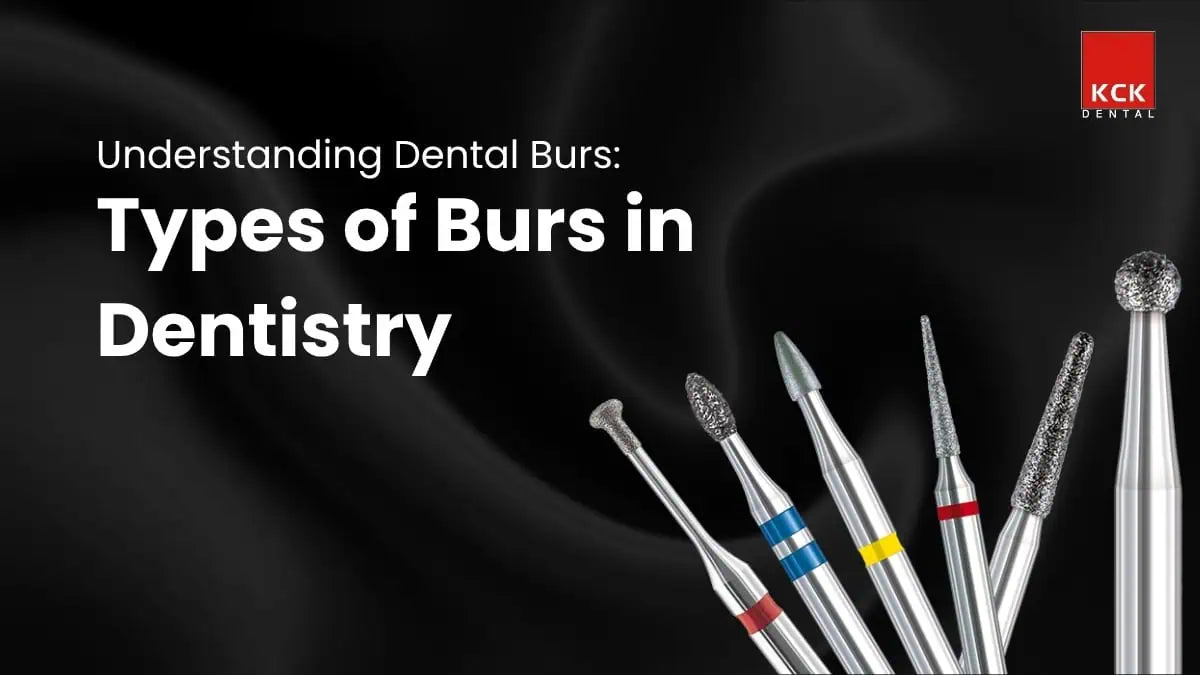Dental burs have undergone significant evolution since their early development. The first burs were handmade, and it wasn’t until 1891 that machine-made burs were introduced. Over the years, dentists have utilized various types of burs for a range of procedures, including drilling cavities and shaping crowns.
Steel burs were among the first to be used with rotary dental drills. Although they aren’t as common today, they’re still useful for certain tasks, such as working with amalgam fillings. Diamond burs came next in 1897 and became more advanced by 1932.
These are perfect for cutting enamel, shaping restorations, and polishing teeth. Then came carbide burs in 194; a sharp, strong, and ideal for cutting both natural teeth and dental materials.
As dentistry has advanced, so have the tools. Today, each type of bur plays a unique role in helping dentists work more efficiently and accurately.
So, let's look at the different types of dental burs used in dentistry, how they differ, and what purposes they serve.
Let’s begin with the basics of dental burs.
What Are Dental Burs?

Dental burs are tiny, rotating tools that dentists use to cut, shape, grind, or polish teeth and bone. They are attached to a dental handpiece and play a key role in many treatments.
Dentists use dental burs in various procedures. General dentists use them to remove cavities, shape teeth for fillings, or prepare teeth for crowns and bridges.
Endodontists use burs to open up the tooth during root canal treatments.
Oral surgeons use them to cut through bone or remove impacted teeth during surgery.
Prosthodontists use them to shape teeth for dentures or implants.
A dental bur has three main parts:
-
Head – the tip that does the cutting or polishing
-
Neck – connects the head to the shank
-
Shank – the base that fits into the dental drill

There are three main types of dental bur shanks:
-
Handpiece burs (HP): These have a long, straight shank and are used with slow-speed handpieces.
-
Latch-type burs (RA): These have a small notch and fit into low-speed contra-angle handpieces.
-
Friction grip burs (FG): These are shorter and thinner, and dentists use them with high-speed handpieces.
Each type of bur fits a different handpiece, depending on the speed and purpose of the procedure.
So, what exactly are these dental burs used for? Let’s dive in.
Uses of Dental Burs in Dentistry
Dental burs are essential tools that help dentists perform many treatments smoothly and accurately. Here are some common uses:
-
Cavity preparation: Dentists use burs to remove decayed parts of the tooth before placing a filling.
-
Crown preparation: Burs help shape the tooth so a crown can fit perfectly.
-
Crown removal: Dentists use special burs to cut and remove old or damaged crowns.
-
Tooth shaping and polishing: Burs help smooth and shape teeth during cosmetic treatments or after fillings.
-
Finishing restorations: After placing fillings or crowns, dentists use burs to fine-tune and polish the surface for a natural look.
-
Root canal access: Burs help create an opening in the tooth to reach the infected pulp during root canal treatment.
-
Removing old fillings: Dentists use burs to take out worn-out or damaged fillings before placing new ones.
These burs help make dental work more accurate, faster, and more comfortable for the patient.
As we mentioned earlier, dental burs have evolved a lot since their inception. Modern dentistry recommends using different types of dental burs based on the patient’s needs.
Here’s a detailed list that’s worth reading for anyone learning about the different types of dental burs and their uses.
Dental Burs: Types Based on Materials and Shape
Dental burs are divided into different types based on what they are made of, how they are attached to the handpiece, and the shape of their head. Here's a simple breakdown:
Types of Dental Burs by Material
|
Category |
Type |
Primary Uses |
Key Features |
|
By Material |
Diamond Burs |
Cutting hard tooth tissue, cavity preparation, crown work, and finishing. |
Coarse or fine grit for rough or smooth cuts; very hard. |
|
Carbide Burs |
Removing decay, cutting through metal or bone, and splitting teeth during extraction. |
Strong, three times tougher than steel, precise. |
|
|
Gold Burs |
Used mostly on vital teeth, for preparation, trimming, and finishing. |
Vibrates less, provides a smoother finish, and lasts longer than regular burs. |
|
|
Ceramic Burs |
Soft-tissue procedures (cutting gums or tissues). |
Don't heat up easily, great for precise soft tissue cutting without burning. |
|
|
Polishing Burs |
Smoothing and shining dental restorations (zirconia, metal, composite, etc.). |
Improves the appearance and comfort of restorations. |
|
|
Milling Burs |
Used in CAD/CAM milling machines to cut and shape materials (zirconia, E-MAX, PMMA, wax, PEEK) for crowns, bridges, and other restorations. |
Used with automated milling machines. |
|
|
Endo Files (Rotary) |
Cleaning, shaping, and preparing the root canal space during root canal treatments. |
Tiny, flexible. |
Types of Dental Burs by Shank Type
|
Category |
Type |
Primary Uses |
Key Features |
|
By Shank Type |
Friction Grip Burs (FG) |
Most commonly used with high-speed handpieces. |
Various lengths: FGSS (Short), FG (Standard), FGOS (Surgical), FGXL (Extra long). |
|
Latch-Type Burs (RA) |
Attaches to low-speed contra-angle handpieces. |
Locks in with a small latch. |
|
|
Long Straight Shank Burs (HP) |
Used mainly in dental labs or with slow-speed handpieces in clinics. |
Larger and straight. |
Dental Burs Classified by Shape

How to Choose the Right Dental Bur
Choosing the right dental burs is essential for dentists to perform procedures safely, smoothly, and effectively. Dentists select burs carefully based on the material they need to cut, the type of procedure, the handpiece they use, and the patient’s condition.
When working with hard materials like tooth enamel, ceramic crowns, or zirconia, dentists use diamond burs because they can easily cut through tough surfaces. For cutting metal fillings, bone, or dentin, carbide burs are preferred due to their strength and precision.
Ceramic burs are ideal for soft-tissue surgeries or cosmetic work since they produce less heat and reduce patient discomfort.
The shape of the bur also matters, depending on the procedure. Round or pear-shaped burs are commonly used for removing decay and preparing cavities. Flat or tapered burs help shape teeth for crowns or bridges.
For finishing and polishing, dentists use burs with fine grit or special polishing burs to create smooth surfaces. In root canal treatments, round or specialized endodontic burs help open the tooth for access.
The choice of bur also depends on the type of handpiece being used. High-speed handpieces require friction-grip burs that cut quickly and efficiently. Low-speed contra-angle handpieces use latch-type burs, which are better for polishing, trimming, and soft-tissue work.
Slow-speed lab handpieces use long straight shank burs mainly in laboratory settings or surgeries.
Dentists also consider patient factors such as age and sensitivity. For children or patients with sensitive teeth, smaller or finer grit burs are chosen to be gentle. Elderly patients or those with dental restorations need burs that minimize damage. For nervous patients, burs that reduce vibration and heat, like gold or ceramic burs, help make the treatment more comfortable.
Finally, the coarseness of the bur is important. Coarse burs remove large amounts of material quickly, medium grit burs are shaped and smooth during the procedure, and fine or extra-fine burs provide the final polishing for a smooth finish.
By carefully choosing the right dental bur, dentists ensure better results and a more comfortable experience for their patients.

Find the Right Dental Burs at KCK Direct
Choosing the right dental burs makes your dental work faster, easier, and more precise. Whether you need to remove decay, shape a tooth for a filling, or prepare a crown, the right burs helps you get the job done smoothly and safely.
Each bur comes in different materials like diamond, carbide, or steel, and has unique shapes and shank types designed for specific dental tasks. Using the right one means less time, less discomfort for your patient, and better results.
At KCK Direct, we understand how important quality tools are for your practice. That’s why we offer a wide range of dental burs, endo burs, and other dental instruments made with care and precision. Our burs deliver excellent cutting power, durability, and comfort, so you can trust them during every treatment. Whether you’re working on simple fillings or complex procedures, our products help you perform at your best.
Upgrade your dental toolkit today with KCK Direct. Explore our trusted collection of reliable dental equipment and experience the difference high-quality tools make in your daily work. Work smarter, faster, and with confidence every time you treat a patient.
FAQs
What is the most commonly used dental bur?
The 330 pear-shaped bur is one of the most commonly used burs in dentistry. Dentists use it mainly for cavity preparation because its shape helps remove decay and shape the tooth easily.
Which dental bur is best for cutting enamel?
Diamond burs are the best choice for cutting tooth enamel. Enamel is the hardest substance in the human body, and diamond is strong enough to cut it effectively and smoothly.
Are diamond burs better than carbide burs?
Both are good, but they serve different purposes:
-
Diamond burs work better for grinding hard surfaces like enamel or ceramics.
-
Carbide burs are better for cutting and shaping softer materials like dentin or metal.
So, it depends on the job. Dentists often use both types during one procedure.
Can I reuse dental burs?
Yes, you can reuse dental burs if they are labeled as reusable. But make sure you clean and sterilize them properly after each use. If a dental bur becomes dull or damaged, it's safer to replace it.
How long do burs typically last?
The lifespan of a burs depends on its material and how often you use it.
-
Diamond burs can last for about 5–10 uses, depending on the grit and pressure used.
-
Carbide burs may last up to 20 uses if handled carefully.
Replace them if they stop cutting well or start vibrating.
How to clean and sterilize dental burs?
To clean and sterilize dental burs:
-
Rinse them under water right after use.
-
Use a Bur brush or an ultrasonic cleaner to remove debris.
-
Dry them completely.
-
Place them in a sterilization pouch.
-
Autoclave them at the recommended temperature and pressure.
Always follow the manufacturer’s instructions to avoid damaging the bur or reducing its lifespan.


